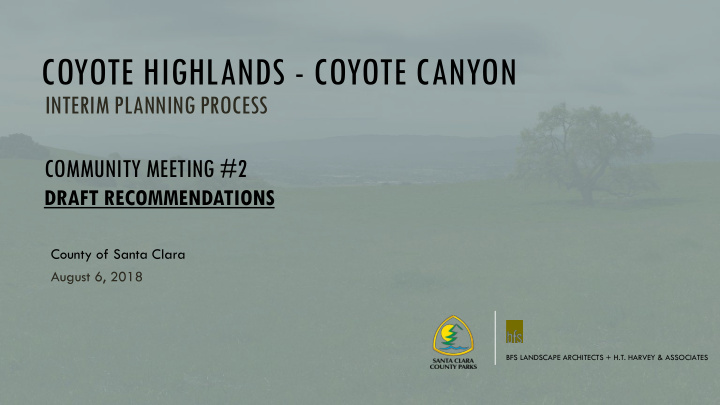



COYOTE HIGHLANDS - COYOTE CANYON INTERIM PLANNING PROCESS COMMUNITY MEETING #2 DRAFT RECOMMENDATIONS County of Santa Clara August 6, 2018 BFS LANDSCAPE ARCHITECTS + H.T. HARVEY & ASSOCIATES
1. Open House 6:00 p.m. 2. Welcome & Housekeeping 6:25 p.m. 3. Presentation 6:30 p.m. Recap of Public Meeting #1 MEETING AGENDA NRM Recommendations Q & A’s Draft Public Access Option Q & A’s 4. Conclusion & Next Steps 7:35 p.m.
PRESENTATION OUTLINE MEETING PURPOSE WHAT ARE WE GOING TO SHARE? 01 02 03 04 05 Planning Recap of Draft NRM Draft Public Next Steps Process Public Recommendations Access Meeting #1 Alignment
BOS Santa Clara County Board of Supervisors CEQA California Environmental Quality Act CHCC Coyote Highlands – Coyote Canyon PLANNING TERMS HLUET Santa Clara County Housing, Land Use, Environment and Transportation Committee NRM Natural Resource(s) Management MND Mitigated Negative Declaration PRC Santa Clara County Parks & Recreation Commission RDM Residual Dry Matter
Community engagement ▪ Share what we have learned ▪ Reflect / address community concerns MEETING PURPOSE: WHY ARE WE HERE?
NEW PROPERTY 1. Understand existing conditions, opportunities and constraints 2. Develop recommendations for public access 3. Identify strategies and practices for maintaining and enhancing natural resources 4. Develop a grazing plan for PLANNING PURPOSE rangeland management
PLANNING PROCESS TO DATE * Additional Opportunities for Public Comment
Topics Discussed: NEW PROPERTY ▪ Existing Conditions ▪ History and Cultural Features ▪ Geography ▪ Biological Resources ▪ Public Access and Trail Alignment Options RECAP OF PUBLIC MEETING #1 WHAT DID WE SHARE WITH YOU?
Important considerations: ▪ Sensitive habitats and species ▪ Proximity of public use near residential areas (fire, access, safety) ▪ Creating safe trails for multi-use ▪ Creating shorter loop option(s) within the RECAP OF PUBLIC MEETING #1 preferred access option WHAT DID YOU SHARE WITH US?
DRAFT RESOURCE MANAGEMENT RECOMMENDATIONS
BACKGROUND OF RESOURCE MANAGEMENT WORK 1. Encompasses entire property 2. Focused resource surveys 3. Management zones 4. NRM plan / best practices 5. Grazing Plan
DRAFT RESOURCE MANAGEMENT RECOMMENDATIONS 1. Monitor / protect occurrences of sensitive plants and communities 2. Exclude cattle from creek to protect water quality and riparian habitat 3. Monitor / protect oak woodlands 4. Survey for and monitor California red- legged frogs, California tiger salamanders, and western pond turtles; enhance pond habitat
DRAFT RESOURCE MANAGEMENT RECOMMENDATIONS 5. Monitor /protect nesting golden eagles and wintering burrowing owls 6. Protect nesting birds during work activities 7. Consider enhancements for roosting bats and nesting barn owls 8. Monitor / manage invasive plants 9. Monitor / control feral pigs
GRAZING PLAN Objectives: ▪ Upland habitat management ▪ Riparian and creek habitat protection and enhancement ▪ Wildfire risk reduction ▪ Invasive plant management
Draft
GRAZING PLAN Current approach appropriate with minor modifications: ▪ Establish performance standards (Residual Dry Matter [RDM] targets) ▪ Utilize standard guidelines for monitoring and adaptive management ▪ Add support infrastructure (fencing, water sources, mineral blocks)
GRAZING PLAN: FIRE SAFETY The Grazing Plan includes: ▪ Keep vegetation down in areas adjacent to residential neighborhoods ▪ Strategically locate salt / nutrient supplements and water to focus grazing ▪ Perform annual survey (late March) to assess grazing performance and, if necessary, adapt management approach
DRAFT RESOURCE MANAGEMENT RECOMMENDATION QUESTIONS/COMMENTS
DRAFT PREFERRED PUBLIC ACCESS RECOMMENDATION
PUBLIC ACCESS ALIGNMENT OPTION #1 CONCEPT North/South trail along Coyote Creek from Coyote Lake – Harvey Bear Ranch County Park to East Dunne Avenue
1. No parking on East Dunne Ave 2. Bridge crossing 3. Narrow road with cliff on east side 4. Parking ½ mile away 5. No existing trail OPTION 1 DETERMINATION connection Feasible, but highly constrained. Not recommended.
PUBLIC ACCESS ALIGNMENT OPTION #3 CONCEPT Development of staging area at Ranch Complex at East Dunne Avenue, with access connecting south to Option #2
1. Difficult to enter and exit property off of E. Dunne Ave. 2. Limited water supply 3. Serpentine soils OPTION 3 DETERMINATION Likely feasible with additional study needed. Not recommended at this time.
PUBLIC ACCESS ALIGNMENT OPTION #2 CONCEPT Loop trail connecting to Coyote Lake – Harvey Bear Ranch County Park
1. Mountain Vistas 2. View of the City of Morgan Hill and the Santa Cruz Mountains 3. Accessible from the Ed Willson Trail 4. Mostly existing infrastructure OPTION 2 DETERMINATION Feasible with relatively moderate construction needed to open. Meets public need, minimizes impacts. Recommended Option.
6.6 miles 5.8 miles 4 miles
ENVIRONMENTAL REVIEW The California Environmental Quality Act (CEQA) requires certain projects and plans to undergo environmental review. A Mitigated Negative Declaration (MND) will likely be prepared. The MND will incorporate mitigation measures to avoid or mitigate significant impacts.
NEXT STEPS • Prepare draft plan document • Conduct environmental review • Presentation to PRC (Fall 2018) • Presentation to HLUET (late Fall 2018) • Recommendation for BOS adoption (late Fall 2018)
QUESTIONS
CONTACT Cherise Orange 408.355.2228 Cherise.orange@prk.sccgov.org Jeremy Farr 408.355.2360 Jeremy.farr@prk.sccgov.org
Recommend
More recommend